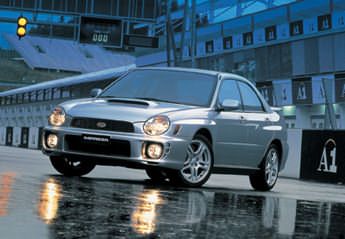|
Rally-inspired WRX
has turbo power - but is it worth $35,000?
When it comes to performance cars, there's a lot of truth to the old
saying, 'Race on Sunday, sell on Monday'. Subaru has been racing in the
World Rally Championship since 1990, and won the championship in 1995,
1996, and 1997 with race-modified Imprezas. They've used these rally
victories in their advertising for the Impreza in the past, and now
they've introduced a car that looks very much like Subaru's current World
Rally car: the 2002 Impreza WRX.
"We used our rally experience to make the new Impreza a lot of fun to
drive with greater levels of power and performance than before," explained
Subaru President Norio Osakabe when the car was announced in January.
Of course, the WRX is not a real rally car - only 'inspired' by
Subaru's rally victories. That means it has a heavier, more durable
all-steel body (except for the aluminum hood), and a comfortable,
well-equipped interior rather than the spartan, low-weight cabin of a
rally car. It also has all the safety features of a regular production
car.
"Owners do not have to compromise the security of their families in
order to enjoy the spirited driving experience that is built into every
Impreza," said Okasabe.
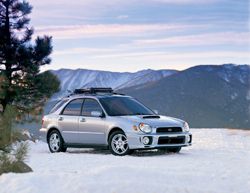
2002 Subaru Impreza WRX wagon
Click image to
enlarge | The WRX is available as a
four-door sedan and a four-door wagon/hatchback - just like the regular
Impreza. You can identify a WRX from the Impreza TS and Outback models by
its large (functional) hood scoop, large rear spoiler, and chrome-tipped
exhausts. It's also available in a unique "World Rally Blue Pearl"
exterior paint.
Special WRX interior features include body-hugging front sport seats,
metallic-look dash trim, leather-wrapped Momo steering wheel, drilled
aluminum alloy pedals, and a standard 6-disc in-dash CD stereo with six
speakers.
The heart of the new WRX is a turbocharged/intercooled 227 horsepower
2.0 litre DOHC 16 valve four cylinder powerplant. That compares to the
non-turbocharged 165 horsepower 2.5 litre SOHC 16 valve four cylinder
engine offered in other Impreza models.
All WRX models come with a standard five-speed manual transmission,
all-wheel-drive, four wheel discs with ABS, fully independent sport-tuned
suspension, and quick ratio steering.
Priced at $34,995 plus $300 freight (sedan or wagon), the WRX has just
one option: a four-speed automatic transmission.
WRX based on
redesigned Impreza
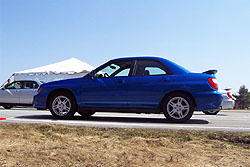
2002 Subaru
Impreza WRX sedan photographed at PMG Technologies proving grounds
in Blaineville, Quebec, April 26, 2001. © CanadianDriver
Communications Inc., 2001, Click image to enlarge
| Based on the redesigned 2002 Impreza, the WRX is
slightly bigger than the previous 2001 Impreza and has a bit more legroom,
headroom and hiproom. The rear seat in particular has been moved back 28
mm and raised 37 mm to increase rear passenger's legroom.
The new body structure is much stiffer than before, improving crash
safety and reducing noise and vibrations. Subaru used a new ring-shaped
reinforcing body structure which increases torsional (twisting) rigidity
by an astounding 147% and bending rigidity up by 82%.
Compared to other compact sedans and hatchbacks, the Impreza is unique:
it has standard all-wheel-drive which provides superior traction and
stability on slippery roads; secondly, it has a horizontally-opposed
'boxer' four cylinder engine which offers a lower centre of gravity than
traditional inline four cylinder engines; and thirdly, the Impreza has a
four-wheel independent MacPherson strut suspension which offers a longer
suspension travel and superior damping characteristics, though it
sacrifices some trunk space.
The WRX builds on these Impreza attributes with its more powerful
engine, a more sophisticated all-wheel-drive system, improved manual and
automatic transmissions, and better brakes.
Driving
impressions
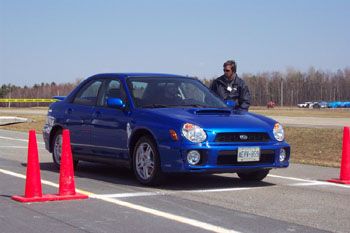
Media test
the 2002 Subaru Impreza WRX at PMG Technologies proving grounds. ©
CanadianDriver Communications Inc., 2001, Click image to
enlarge
| Start the engine, and the WRX's 2.0 litre
horizontally-opposed four-banger growls to life, rumbling and shaking
something like OHV V8's used to do. At idle, you can actually feel the car
shaking from side to side - probably a plus in this car.
The big hood scoop feeds air to the turbocharger intercooler - unlike
the non-functional hood scoop on earlier Subaru Impreza and Legacy Outback
models. The WRX hood is made of lightweight aluminum alloy to reduce
overall vehicle weight.
Acceleration is quick - Subaru of America reports a 0 to 60 mph time of
6.4 seconds, and some U.S. car magazine have reported 0 to 60 under six
seconds. Acceleration is modestly fast up until about 2500 rpm - then the
turbocharger boost really kicks in and the car shoots forwards with a
deep, growling, howling sound which continues up until the redline of 7000
rpm. The boxer engine makes a different kind of sound to an inline or
V-shaped engine - more utilitarian than high-tech.
The turbocharged 2.0 litre engine's maximum torque of 217 lbs-ft. peaks
at 4000 rpm, however there's already over 200 lbs-ft of torque available
at 2700 rpm. By keeping the engine in the 3000 rpm range, there's always
plenty of throttle response.
Cruising in fifth gear on the freeway, the engine does a comfortable
2,500 rpm, and at 120 km/h, it does 3000 rpm - both reasonable for highway
cruising.
The standard five-speed manual transmission offers medium-length, easy
gear throws. Clutch effort is light and there's a large dead pedal to the
left of the clutch pedal to rest your foot when not changing gears.
Though its 2.0 litre engine is rather small, fuel consumption is not
particularly thrifty: In the city, expect no more than 11.6 l/100 km (24
mpg), and on the highway, you might get up to 8.0 l/100 km (35 mpg). With
a four-speed automatic transmission, those figures are 12.3 l/100 km
(23mpg) and 8.2 l/100 km (34 mpg).
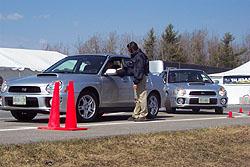
WRX sedan and
wagon wait to run at PMG Technologies proving grounds. ©
CanadianDriver Communications Inc., 2001, Click image to
enlarge
| WRX's equipped with the four-speed automatic
transmission have a new VTD (variable torque distribution) system which
includes a planetary gear-type centre differential and
electronically-controlled hydraulic transfer clutches which automatically
transfer more power to the front or rear wheels if the one end begins to
slip. There's also a limited slip rear differential that helps prevent one
rear wheel spinning.
On dry surfaces, you won't even notice the car has all-wheel-drive.
There's no extra noise or vibrations to give it away, and it's completely
automatic. But on loose gravel, wet roads, ice or snow, you'll notice all
four wheels doing the pulling rather than just the front or rear wheels.
This not only provides extra traction, but helps prevent the rear-end from
swinging out when cornering (oversteer), or the front-end from 'ploughing'
when cornering (understeer).
In addition, the WRX's all-wheel-drive provides greater high-speed
stability when cornering on dry surfaces because tires do slip at the
limit and the all-wheel-drive compensates by transferring power to the
tires with the most grip. This is more important in the 'real world' than
on race-tracks which have smooth, predictable surfaces. And of course,
all-wheel-drive is ideal for rallying on unpaved roads.
With a sport-tuned independent MacPherson strut suspension, standard
Bridgestone Potenza RE92 P205/55R-16 inch radials, and relatively short
wheelbase, the WRX handles well on smooth and rough surfaces and can take
a lot of punishment. The suspension soaks up large and small bumps with
ease and its highway ride is very comfortable. A 10.8 metre turning circle
is a bit more than I would have liked.
For all its performance acumen however, the WRX is really quite
civilized. Outward visibility is good, the ride is comfortable, it's roomy
enough for four adults, and has a roomy trunk. It could double as an
everyday family car!
Rally
interior
My 'World Rally Blue Pearl'-coloured test car had a black cloth
interior with blue seat inserts. The front sport seats have side and thigh
bolstering for support during enthusiastic driving, and the driver's seat
is height-adjustable using a pump lever. The gauge cluster consists of
three round dials - a central speedometer, tachometer and fuel/coolant
gauges. I noticed there isn't a turbo boost gauge. The sporty interior
offers metallic-look trim surrounding the centre instrument panel, air
vents, and the three round gauges.
A thick-rimmed, leather-wrapped 4-spoke Momo steering wheel with
dimpled hand grips, leather-wrapped shift knob and handbrake lever add to
the racy feel and look of the interior. Drilled aluminum pedals also add
racing panache.
Most of the controls are easily accessible and where you'd expect them
to be - with the possible exception of the power mirror buttons which are
on the centre tunnel. Cruise control includes a main Cruise button on the
left dash, and a stalk under the steering wheel for controlling
Set/Resume/Accelerate functions.
A newly-designed pull-out cupholder just above the radio slides out to
the side so that large cups won't block the radio. And there's another,
smaller cupholder between the front seats.
Interior storage space is limited. A covered centre storage bin is
quite small, and there is a small coin tray to the left of the steering
wheel, front door map pockets, and a small glovebox.
Rear legroom is OK for an adult and the high roofline affords generous
rear headroom. There are three three-point rear seatbelts, but it's more
comfortable for two passengers. At the rear, there is a folding centre
armrest with a pass-through to the trunk, but WRX sedans do not offer
folding rear seatbacks. Only WRX wagons do.
The notchback styling of the WRX sedan contributes to a expansive
'greenhouse' that maximizes visibility. Even the extra large rear spoiler
doesn't impede rear visibility significantly.
Price and
features
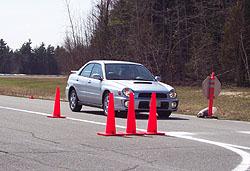
WRX sedan
brakes at end of slalom course, April 2001. © CanadianDriver
Communications Inc., 2001, Click image to enlarge
| Both the WRX sedan and WRX wagon are priced at
$34,995 - the only option available is a 4-speed automatic transmission
($1,200).
Standard equipment on both models includes all-wheel-drive, the 227
horsepower motor and 5-speed manual transmission, four disc brakes with
ABS, 205/55R-16 inch tires and alloy wheels, front fog lamps, air
conditioning, premium stereo with 6 disc in-dash CD, heated front sport
seats, keyless entry, cruise control, power windows with driver's auto
down, power door locks, power heated mirrors, variable intermittent
wipers, tilt steering column, leather wrapped Momo steering wheel, and
front and side airbags.
WRX Wagon models add split 60/40 folding rear seatbacks, rear
wiper/washer, roof rack, cargo cover, and 12 volt outlet in the cargo
area.
The WRX is about $8,000 more than an Impreza 2.5RS sedan - that seems a
bit excessive to me, particularly as the WRX doesn't have leather
upholstery or automatic climate control. But the WRX's class-leading
horsepower, rally genes, and killer-looks will undoubtedly appeal to many.
For more info, see Subaru Canada's web-site, www.subaru.ca or their WRX
web-site, www.wrx.ca.
See also: First Drive:
2002 Subaru Impreza WRX.
Technical Data:
| 2002 Subaru
Impreza WRX sedan |
| Base price |
$34,995 |
| Price as tested |
$34,995 |
| Freight |
$300 |
| Type |
4-door, 5 passenger compact
sedan |
| Layout |
longitudinal front
engine/all-wheel-drive |
| Engine |
2.0 litre 4 cylinder,
horizontally-opposed, DOHC, 16 valves, turbocharger with
intercooler |
| Horsepower |
227 @ 6000 rpm |
| Torque |
217 lb-ft @ 4000
rpm |
| Transmission |
5 speed manual (4-speed
automatic) |
| Tires |
P205/55R-16
inch |
| Curb weight |
1399 kg (3084
lb.) |
| Wheelbase |
2525 mm (99.4
in.) |
| Length |
4405 mm (173.4
in.) |
| Width |
1730 mm (68.1
in.) |
| Height |
1440 mm (56.7
in.) |
| Cargo capacity |
311 litres (11.0 cu.
ft.) |
| Fuel consumption |
City: 11.6 l/100 km (24
mpg) |
| |
Hwy: 8.0 l/100 km (35 mpg)
|
| Warranty |
3 yrs/60,000
km |
| Powertrain
warranty |
5 yrs/100,000
km | |





